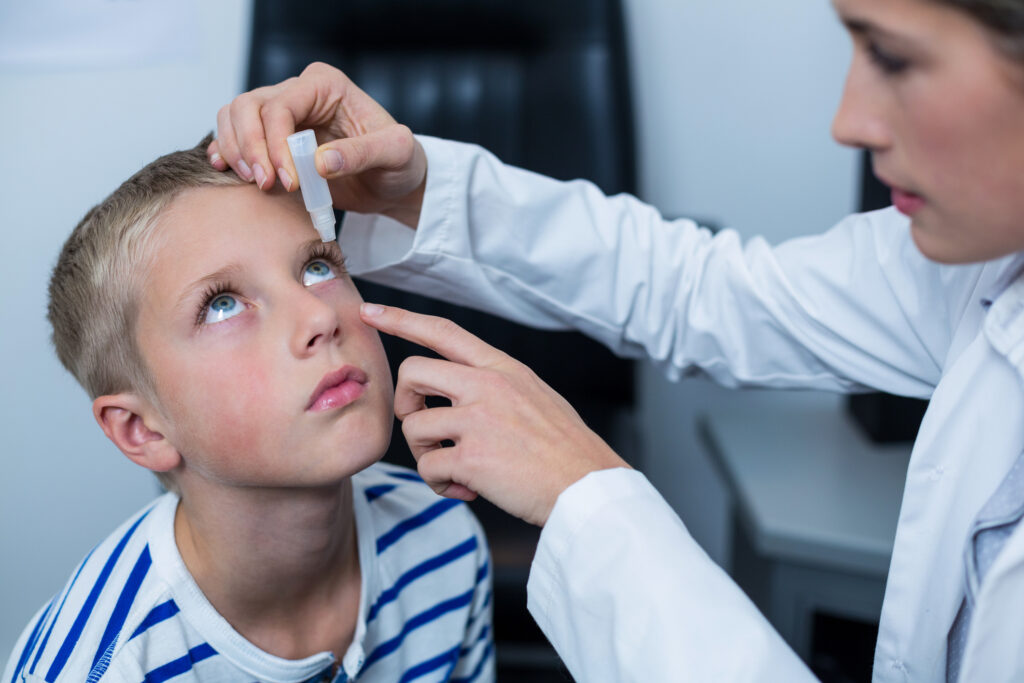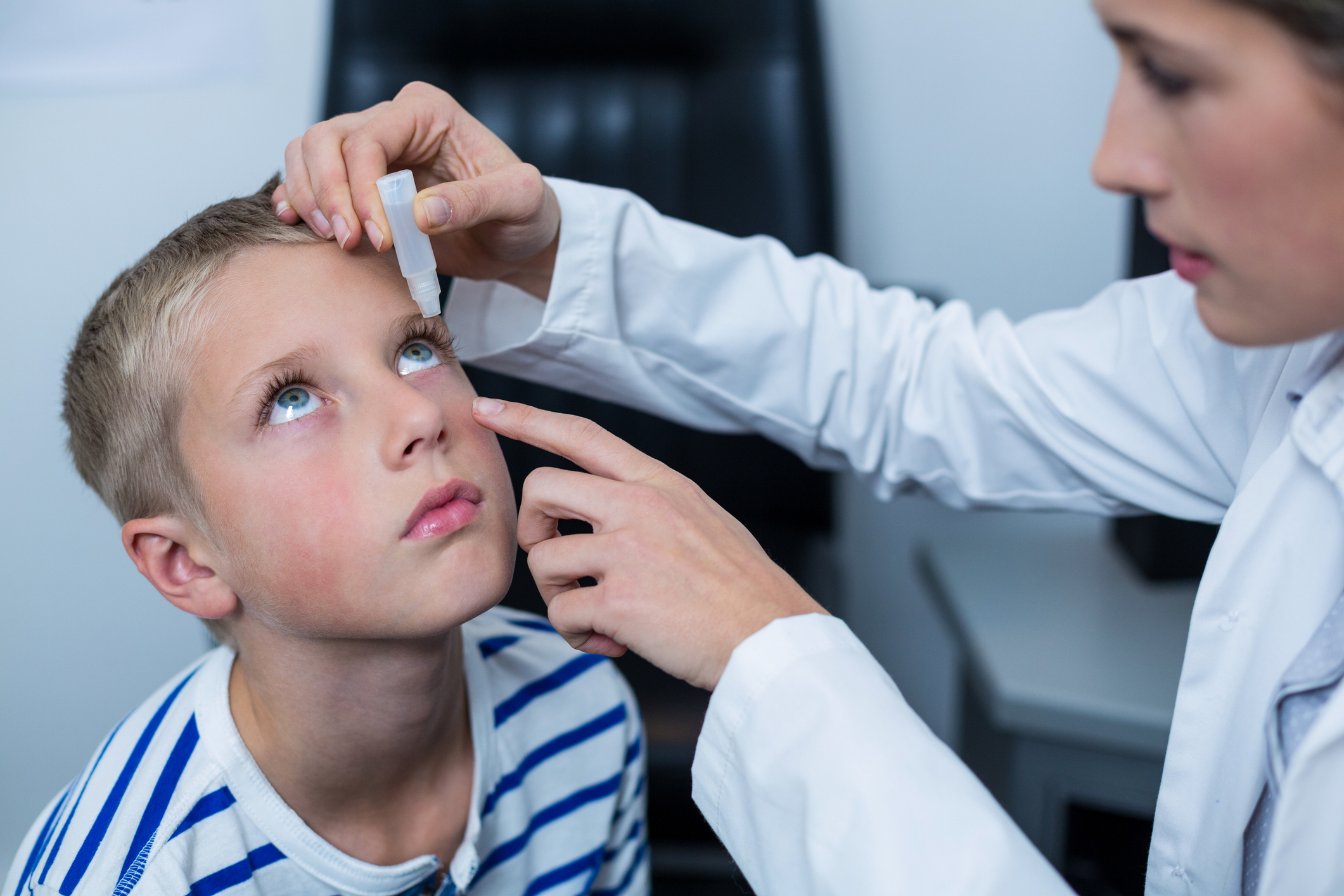
Nearsightedness, or myopia, is becoming increasingly common among children in Canada. A person with myopia (commonly known as short-sightedness) requires glasses to see objects clearly at a distance, such as across a room. While this may seem like a minor inconvenience, progressive or worsening myopia can pose significant eye health risks over a lifetime. Eye diseases such as retinal detachment, glaucoma, and myopic maculopathy are associated with high levels of myopia,1 which can occur in adulthood, making early treatment in childhood essential to reduce these risks. Myopia treatments, known as myopia control or management, are designed to slow the progressive worsening of myopia that usually occurs during childhood. These treatments help provide children with more stable vision between eye exams in the short term while also reducing long-term eye health risks.
One promising myopia control treatment option is low-dose atropine eye drops, which have been extensively studied for their ability to slow down the progression of myopia in children.
What Are Atropine Eye Drops?
Atropine is a medication that has been used in eye care for over a century. In high concentrations (1%), it has been prescribed to expand the pupil of the eye and temporarily stop the eye’s up-close focusing ability. This is used for diagnostic tests and in management of some eye conditions like amblyopia (lazy eye) and eye inflammation. However, research over the past decade has identified that much lower concentrations (0.01% to 0.05%) can significantly slow myopia progression in children with minimal side effects.2
How Do Atropine Eye Drops Work?
Although the exact mechanism is not fully understood, atropine is believed to slow myopia progression by influencing eye growth. It can slow down the excessive eye growth which occurs in myopia to the slower rate typically seen in childhood, by working on chemical signals in the retina. The retina is the light sensitive layer or film at the back of the eye.3
Early studies of atropine for myopia control used a 1% concentration, which was highly effective but caused significant side effects such as light sensitivity to bright light (squinting and discomfort) and blurred vision for up-close tasks like reading. More recent research has focused on lower concentrations ranging from 0.01% to 0.05%, which still slow eye growth but with minimal unwanted effects.4
Atropine’s impact on myopia progression appears to be dose-dependent. The most effective concentrations currently studied are 0.025% to 0.05%, as they provide a strong slowing effect on myopia progression while maintaining minimal side effects. It’s important to note that the ideal concentration and the side effects can vary from child to child. This remains an area of active research.4,5
For best results, atropine is typically used once daily, in the evening. This ensures that any mild side effects, such as slight light sensitivity or mild close-up focusing difficulties, do not interfere with daily activities such as schoolwork (read more in the next section on potential side effects). Importantly, atropine does not correct the blurred far vision caused by myopia on its own — children will still need to wear glasses or contact lenses for clear vision while undergoing atropine treatment.
Potential Side Effects
The main side effects of atropine eye drops relate to their effect on pupil size and near vision focusing ability:
- Mild pupil enlargement: This can cause increased sensitivity to light, which may be managed by using sunglasses or photochromic spectacle lenses.5,6
- Reduced near vision focus: This effect is more pronounced with higher concentrations. If a child experiences difficulty reading, progressive or bifocal lenses may be prescribed to aid near work.6
- Risks if swallowed: Though minimal at low doses, atropine should always be stored securely out of reach of children. If accidentally ingested, atropine can cause serious systemic effects such as increased heart rate, dry mouth, and fever. Parents should seek immediate medical attention in such cases.7,8
The Use of Atropine for Myopia Control in Canada
Off-Label Prescription
In Canada, atropine eye drops for myopia management are considered an off-label use. This means that while atropine is approved for other eye conditions, it is not specifically labelled for myopia control. However, this does not mean it is unsafe or ineffective. Many medications are used off-label when research supports their benefits for conditions beyond their original approval.
How Are Atropine Eye Drops Accessed in Canada?
Low-dose atropine is not commercially available and must be specially prepared by a compounding pharmacy. Most pharmacies can either recommend a compounding location or order the drops upon request. As myopia management gains awareness, more pharmacies are beginning to stock these drops routinely.
Who Prescribes Atropine for Myopia Control in Canada?
Atropine treatment should always be prescribed and monitored by an eye care professional. In Canada, optometrists and ophthalmologists can prescribe atropine eye drops. Optometrists also typically offer additional myopia control treatments such as specialized glasses and contact lenses. Regular eye exams are essential to assess treatment effectiveness and make any necessary adjustments.
Combining Atropine with Other Myopia Treatments
While atropine has shown great promise, it is not the only approach to myopia control. Other interventions include:
- Orthokeratology (Ortho-K): Specially designed contact lenses worn overnight to temporarily reshape the cornea and reduce myopia progression.
- Multifocal Contact Lenses: These lenses are designed with different focusing zones to reduce eye strain and slow myopia progression.
- Myopia Control Spectacle Lenses: Some new spectacle lens designs help slow eye growth and reduce myopia progression.
Combining atropine with these approaches may enhance the overall effectiveness of myopia control, and an optometrist can help determine the best individualized strategy for your child.
Long-Term Considerations for Atropine Use
Research suggests that the optimal duration for atropine treatment is two to three years,4,8 with regular monitoring to determine whether continued use is necessary. Some children may need to continue treatment beyond this period if their myopia continues to progress. Additionally, studies indicate that a gradual tapering of atropine concentration at the end of treatment may help prevent rebound effects, where myopia progression accelerates after stopping treatment.9
Are Atropine Eye Drops Right for Your Child?
Atropine eye drops offer a scientifically supported method for slowing myopia progression in children. They can be used as a solo treatment, with standard glasses or contact lenses also prescribed to give your child clear vision; or they can be combined with other specialized myopia control methods, which may improve outcomes in some children. For any questions you have about myopia management, speak to your child’s optometrist for personalized advice and guidance.
References
- Bullimore MA, Ritchey ER, Shah S, Leveziel N, Bourne RRA, Flitcroft DI. The Risks and Benefits of Myopia Control. Ophthalmology. 2021 Nov;128(11):1561-1579.
- Zaabaar E, Zhang Y, Kam KW, Zhang XJ, Tham CC, Chen LJ, Pang CP, Yam JC. Low-concentration atropine for controlling myopia onset and progression in East Asia. Asia Pac J Ophthalmol (Phila). 2024 Nov-Dec;13(6):100122.
- Lin HJ, Wan L, Chen WC, Lin JM, Lin CJ, Tsai FJ. Muscarinic acetylcholine receptor 3 is dominant in myopia progression. Invest Ophthalmol Vis Sci. 2012 Sep 21;53(10):6519-25.
- Yam JC, Jiang Y, Tang SM, Law AKP, Chan JJ, Wong E, Ko ST, Young AL, Tham CC, Chen LJ, Pang CP. Low-Concentration Atropine for Myopia Progression (LAMP) Study: A Randomized, Double-Blinded, Placebo-Controlled Trial of 0.05%, 0.025%, and 0.01% Atropine Eye Drops in Myopia Control. Ophthalmology. 2019 Jan;126(1):113-124.
- Chia A, Chua WH, Cheung YB, Wong WL, Lingham A, Fong A, Tan D. Atropine for the treatment of childhood myopia: safety and efficacy of 0.5%, 0.1%, and 0.01% doses (Atropine for the Treatment of Myopia 2). Ophthalmology. 2012 Feb;119(2):347-54.
- Chua WH, Balakrishnan V, Chan YH, Tong L, Ling Y, Quah BL, Tan D. Atropine for the treatment of childhood myopia. Ophthalmology. 2006 Dec;113(12):2285-91.
- Stellpflug SJ, Cole JB, Isaacson BA, Lintner CP, Bilden EF. Massive atropine eye drop ingestion treated with high-dose physostigmine to avoid intubation. West J Emerg Med. 2012 Feb;13(1):77-9.
- Cui C, Li X, Lyu Y, Wei L, Zhao B, Yu S, Rong J, Bai Y, Fu A. Safety and efficacy of 0.02% and 0.01% atropine on controlling myopia progression: a 2-year clinical trial. Sci Rep. 2021 Nov 15;11(1):22267.
- Gifford KL, Richdale K, Kang P, Aller TA, Lam CS, Liu YM, Michaud L, Mulder J, Orr JB, Rose KA, Saunders KJ, Seidel D, Tideman JWL, Sankaridurg P. IMI – Clinical Management Guidelines Report. Invest Ophthalmol Vis Sci. 2019 Feb 28;60(3):M184-M203.



